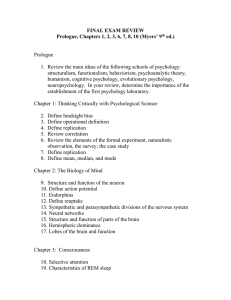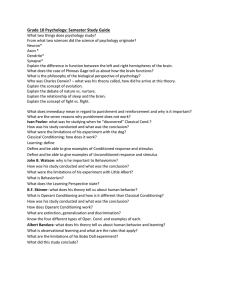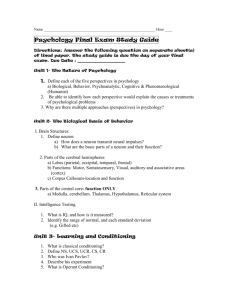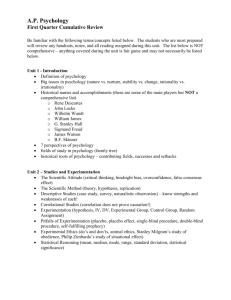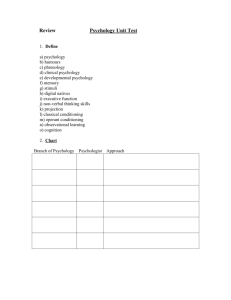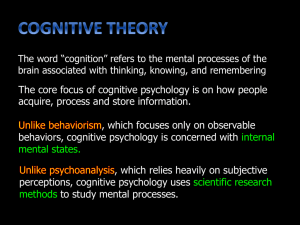Chapter 1: Research Chapter 5: Learning Chapter 6: Memory
advertisement
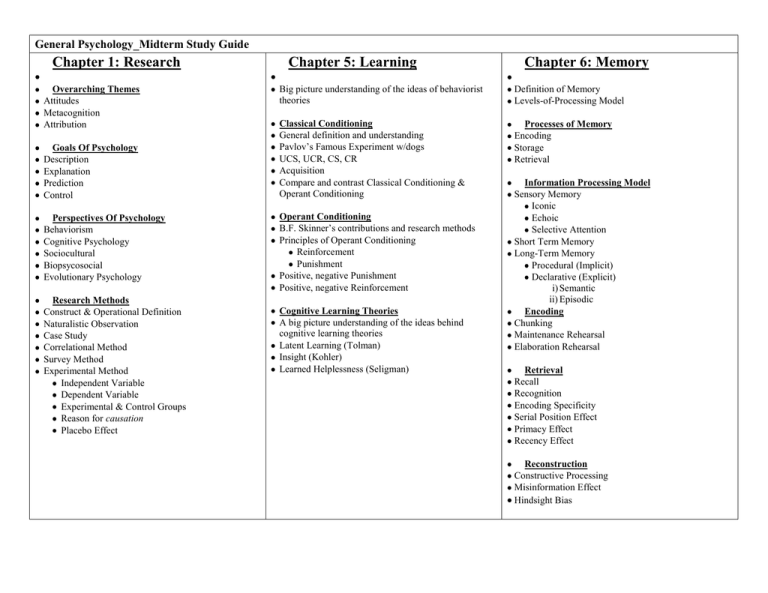
General Psychology_Midterm Study Guide Chapter 1: Research Overarching Themes Attitudes Metacognition Attribution Goals Of Psychology Description Explanation Prediction Control Perspectives Of Psychology Behaviorism Cognitive Psychology Sociocultural Biopsycosocial Evolutionary Psychology Research Methods Construct & Operational Definition Naturalistic Observation Case Study Correlational Method Survey Method Experimental Method Independent Variable Dependent Variable Experimental & Control Groups Reason for causation Placebo Effect Chapter 5: Learning Chapter 6: Memory Big picture understanding of the ideas of behaviorist theories Definition of Memory Levels-of-Processing Model Classical Conditioning General definition and understanding Pavlov’s Famous Experiment w/dogs UCS, UCR, CS, CR Acquisition Compare and contrast Classical Conditioning & Operant Conditioning Processes of Memory Encoding Storage Retrieval Operant Conditioning B.F. Skinner’s contributions and research methods Principles of Operant Conditioning Reinforcement Punishment Positive, negative Punishment Positive, negative Reinforcement Cognitive Learning Theories A big picture understanding of the ideas behind cognitive learning theories Latent Learning (Tolman) Insight (Kohler) Learned Helplessness (Seligman) Information Processing Model Sensory Memory Iconic Echoic Selective Attention Short Term Memory Long-Term Memory Procedural (Implicit) Declarative (Explicit) i) Semantic ii) Episodic Encoding Chunking Maintenance Rehearsal Elaboration Rehearsal Retrieval Recall Recognition Encoding Specificity Serial Position Effect Primacy Effect Recency Effect Reconstruction Constructive Processing Misinformation Effect Hindsight Bias Chapter 2: Biological Perspective The Nervous System General definition and understanding Central Nervous System Brain Spinal Cord Peripheral Nervous System Autonomic Somatic Parasympathetic Sympathetic Components of the Neuron Soma Dendrites Axon Myelin Synaptic Knob Components of Communication Action Potential Neurotransmitters Synapse Receptor Sites Reuptake Brain Structure/Function Hindbrain, Limbic System, Cortex Medulla, Cerebellum, Frontal Lobe, Parietal Lobe, Temporal Lobe, Occipital Lobe, Somtosensory Cortex, Motor Cortex, Thalamus, Hypothalamus, Amygdala, Hippocampus Chapter 3 : Sensation and Perception General understanding of what sensation is Understanding of what transduction is Chemical Senses: Taste Big picture of the sensation of taste Taste buds/receptor cells (where they are and how they work) Chemical Senses: Smell How smell works Cilia and receptor cells Olfactory bulbs Explanation for why we “taste” more when we are able to smell Structure of the Eye Know the function and structure of: Cornea, Iris, Pupil, Lens, Retina, Rods and Cones Know the function of bipolar neurons and ganglion cells Know the reason for the blind spot Perception Definition and general understanding Perceptual expectancy Top-Down Processing Bottom-Up Processing Gestalt Psychology Big Picture Figure-ground, Proximity, Similarity, Closure, Continuity Chapter 7: Cognitive Definition of Cognition Tools Mental Images Concepts Prototypes Definition of Problem Solving Facilitation of Problem Solving Heuristics Insight Creativity Convergent Thinking Divergent Thinking Barriers to Problem Solving Functional Fixedness Mental Sets Confirmation Bias Chapter 8 Developmental Piaget’s Cognitive Development Sensorimotor o Object Permanence Preoperational o Centration Concrete Operations Formal Operations
